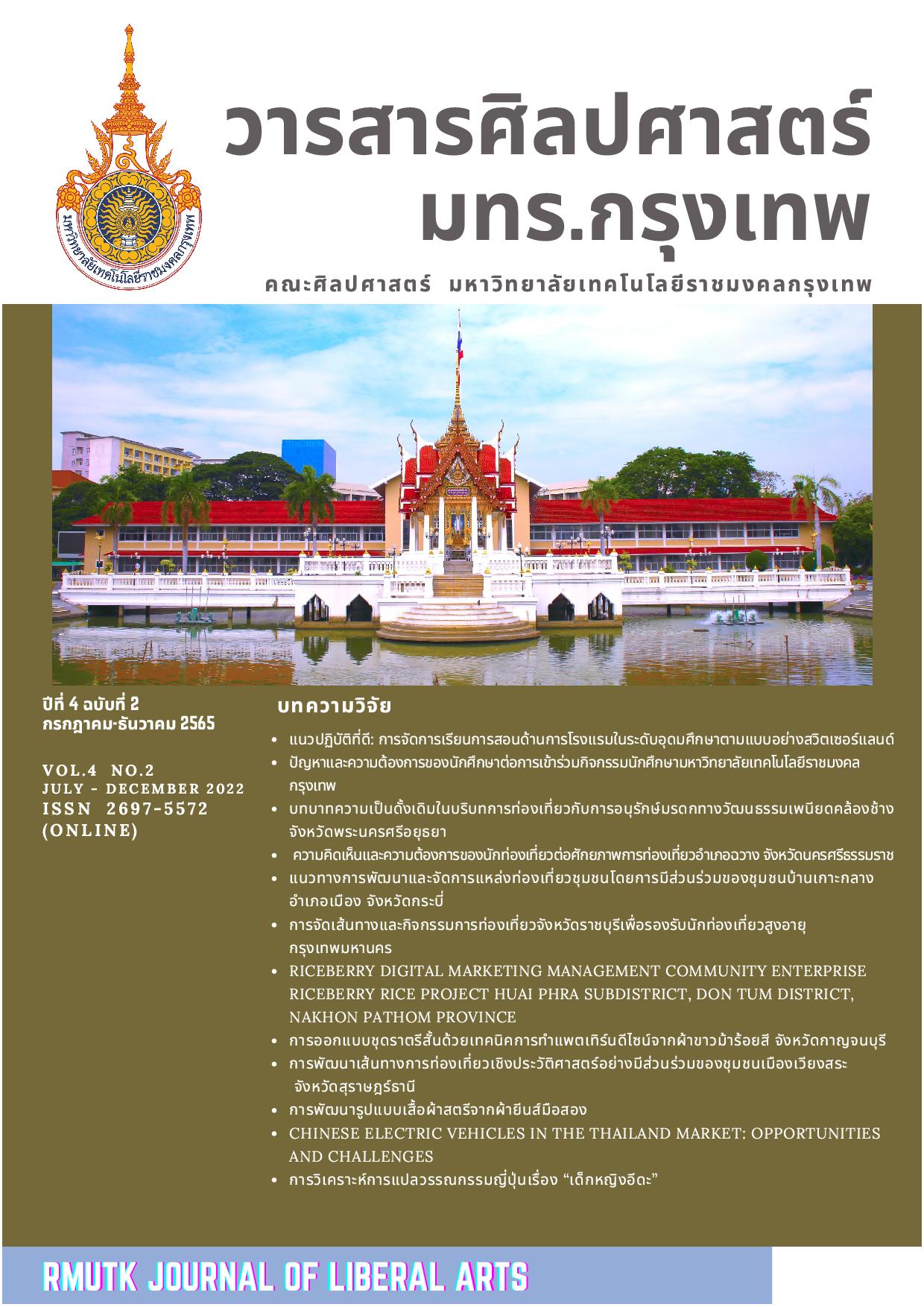DESIGN OF SHORT EVENING DRESS WITH PATTERN DESIGN TECHNIQUE FROM A HUNDRED COLORED LOINCLOTH, KANCHANABURI PROVINCE
Main Article Content
Abstract
The research on the Design of Short Evening Dresses with Pattern Design Techniques from a Hundred Colored Loincloths from Kanchanaburi has two goals: 1) to design and make cocktail dresses with pattern techniques from a hundred coloured loincloths from Kanchanaburi, and 2) to study the satisfaction of the designed and made cocktail dresses with pattern techniques from a hundred coloured loincloth from Kanchanaburi. The target group was working women at Rat Burana District Office, Bangkok, for 52 people. The research tool is a questionnaire on satisfaction. The samples are selected with the purposive sampling technique. The data is analyzed for percentages, means, and standard deviations (SD). The findings point out that a hundred coloured loincloths have unique colours that show the local identity. Each fabric consists of a weft and a warp, creating a strange beauty. The filament is artificial thread, silky like artificial silk, with colours that have not faded, and is comfortable to wear. The loincloth is used for making cocktail dresses by using pattern techniques that have pleats and drapes in rhythms to make the designed dresses look extravagant and modern. The dresses designed with patterns and a hundred coloured loincloths of Kanchanaburi are in 10 sets. From the ten dresses, the experts in designing have selected five sets. I, the researcher, used the five dresses selected by the experts to make prototype dresses and survey the female samples’ satisfaction with the pattern design. The findings from the research show that the overall satisfaction for each dress shows that dresses 5, 3, 4, and 2 are satisfying at the highest level, respectively, with Dress 1 having the lowest mean. Concerning each aspect separately, for dresses 5, 3, 4 and 2, with the highest satisfaction levels, the samples focus on materials and dressmaking as the essential aspects, followed by the aspect of designing, with the aspect of a function having the lowest mean. As for Dress 1, the samples show that the most important parts are the materials and how the dress is made, followed by the function, and the design has the lowest mean.
Article Details

This work is licensed under a Creative Commons Attribution-NonCommercial-NoDerivatives 4.0 International License.
References
จรัสพิมพ์ วังเย็น และคณะ. (2556). การพัฒนาผลิตภัณฑ์จากผ้าขาวม้าโดยใช้แนวคิดภูมิปัญญาท้องถิ่นกับแนวคิด การออกแบบแฟชั่นเพื่อพัฒนาอาชีพและผลิตภัณฑ์ชุมชน อำเภอวานรนิวาส จังหวัดสกลนคร. กรุงเทพฯ: คณะอุตสาหกรรมสิ่งทอและออกแบบแฟชั่น มหาวิทยาลัยเทคโนโลยีราชมงคลพระนคร.
ดวงดาว ท่ามตระกูล. (2548). การตัดเย็บขั้นสูง. กรุงเทพฯ: อมรินพริ้นติ้งแอนด์พับลิชชิ่ง.
ธนิดา แหลมฉลาด และโฆสิต แพงสร้อย. (202). การพัฒนาลวดลายผ้าขาวม้าทอมือเพื่อเพิ่มมูลค่าทางเศรษฐกิจของชุมชนจังหวัดร้อยเอ็ด. Journal of MCU Peace Studies, 8(3), 1152-1165.
ธานินทร์ ศิลป์จารุ. (2560). การวิจัยและวิเคราะห์ข้อมูลทางสถิติด้วย SPSS และ AMOS. (พิมพ์ครั้งที่ 17). กรุงเทพฯ: สามัญบิสซิเนสอาร์แอนด์ดี.
ธีร์ โคตรถา. (2561). การสร้างสรรค์และพัฒนากลุ่มสินค้าแฟชั่นสตรีมุสลิมสำเร็จรูป กลุ่มวิสาหกิจชุมชนมุสลิม บ้านรานอ อำเภอบันนังสตา จังหวัดยะลา. Veridian E-Journal, Silpakorn University, 11(3), 3007-3023.
ธีร์ โคตรถา. (2021). แนวทางการสร้างสรรค์กลุ่มสินค้าแฟชั่นสำเร็จรูปด้วยหลักการเทคนิคเมจิกแพตเทิร์นสำหรับตลาด สินค้าแฟชั่นผู้สูงอายุประเทศไทย. Journal of Fine and Applied Arts, Chulalongkorn University, 8(2), 55-70.
ผ้าขาวม้าร้อยสี บ้านหนองขาว. (ม.ป.ป.). สืบค้นจาก: https://www.painaidii.com/business/134200/photo/ (วันที่สืบค้น 8 มกราคม 2564).
ผ้าขาวม้าร้อยสี สะท้อนความสามัคคีของชุมชนหนองขาว. (2559). สืบค้นจาก: https://district.cdd.go.th/district-2/2016/10/03 (วันที่สืบค้น 16 กรกฎาคม 2564).
รัตนาเลขา มีพร้อม และ อดิเทพ สุรพงษ์พิวัฒนะ. (2560). การออกแบบเสื้อคลุมสตรีจากผ้าขาวม้าด้วยเทคนิคการปรับแบบตัด. ใน การประชุมวิชาการมหาวิทยาลัยเทคโนโลยีราชมงคลธัญบุรี สาขาสถาปัตยกรรมศาสตร์ ศิลปกรรมและการสร้างสรรค์. 201–209.
วีระศักดิ์ ศรีลารัตน์. (2558). การพัฒนาลวดลายผ้าฝ้ายมัดหมี่ย้อมครามด้วยเทคนิคคณิตศิลป์ประเภท Tessellation เพื่อ ออกแบบชุดโอกาสพิเศษ. กรุงเทพฯ: มหาวิทยาลัยเทคโนโลยีราชมงคลพระนคร.
สุภาพ ศรีวงษา และคณะ. (2564). การออกแบบชุดติดกันด้วยเทคนิคการสร้างแพตเทิร์นสามมิติจากผ้ามัดหมี่ จังหวัดลพบุรี. วารสารศิลปศาสตร์ มหาวิทยาลัยเทคโนโลยีราชมงคลกรุงเทพ, 3(2), 37-48.
Richard Sorger, Jenny Udale (2012). The Fundamentals of Fashion Design. AVA Publishing SA, United Kingdom.
Srisuk, K. (2016). Nameunsi and Koh Yor Woven Fabric: The Application of Creative Economy Concepts to Develop Products for the Development of Community Economy. Social Sciences Research and Academic Journal, 11(33), 87-100.
Waikla, R. (2019). Local Wisdom and Conservation of Phutai Traditions. Journal of Arts Management, 3(1), 53-68.


